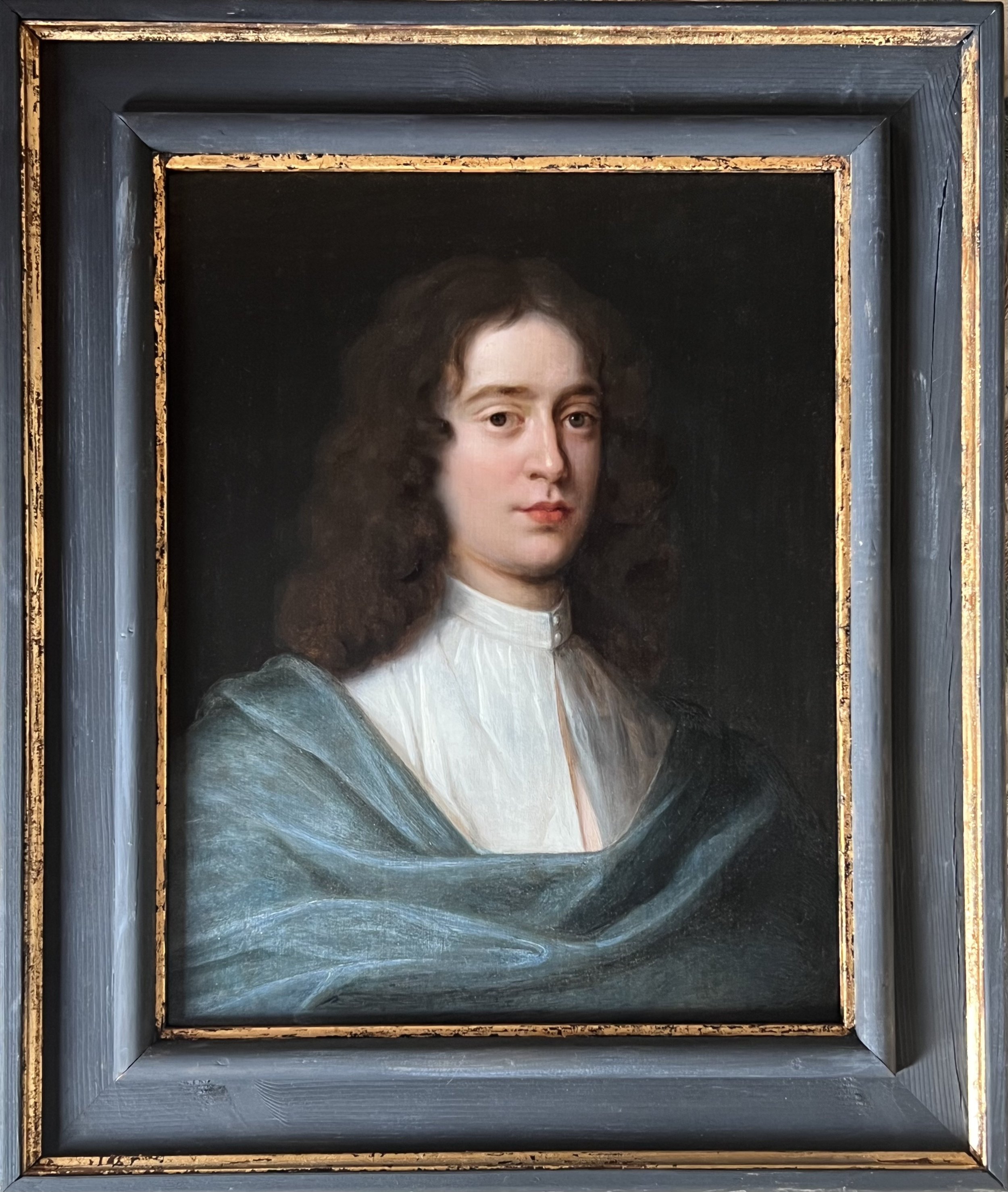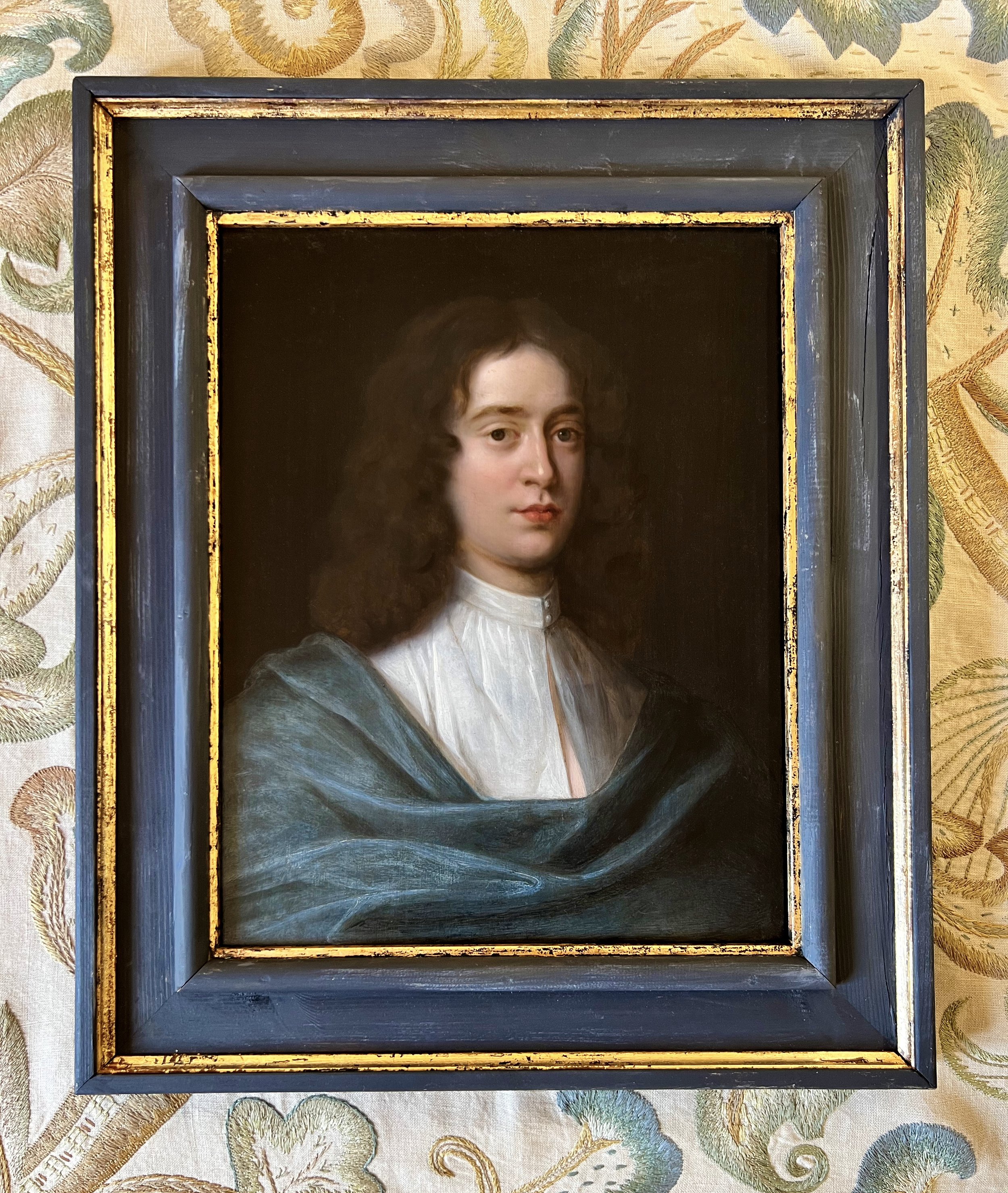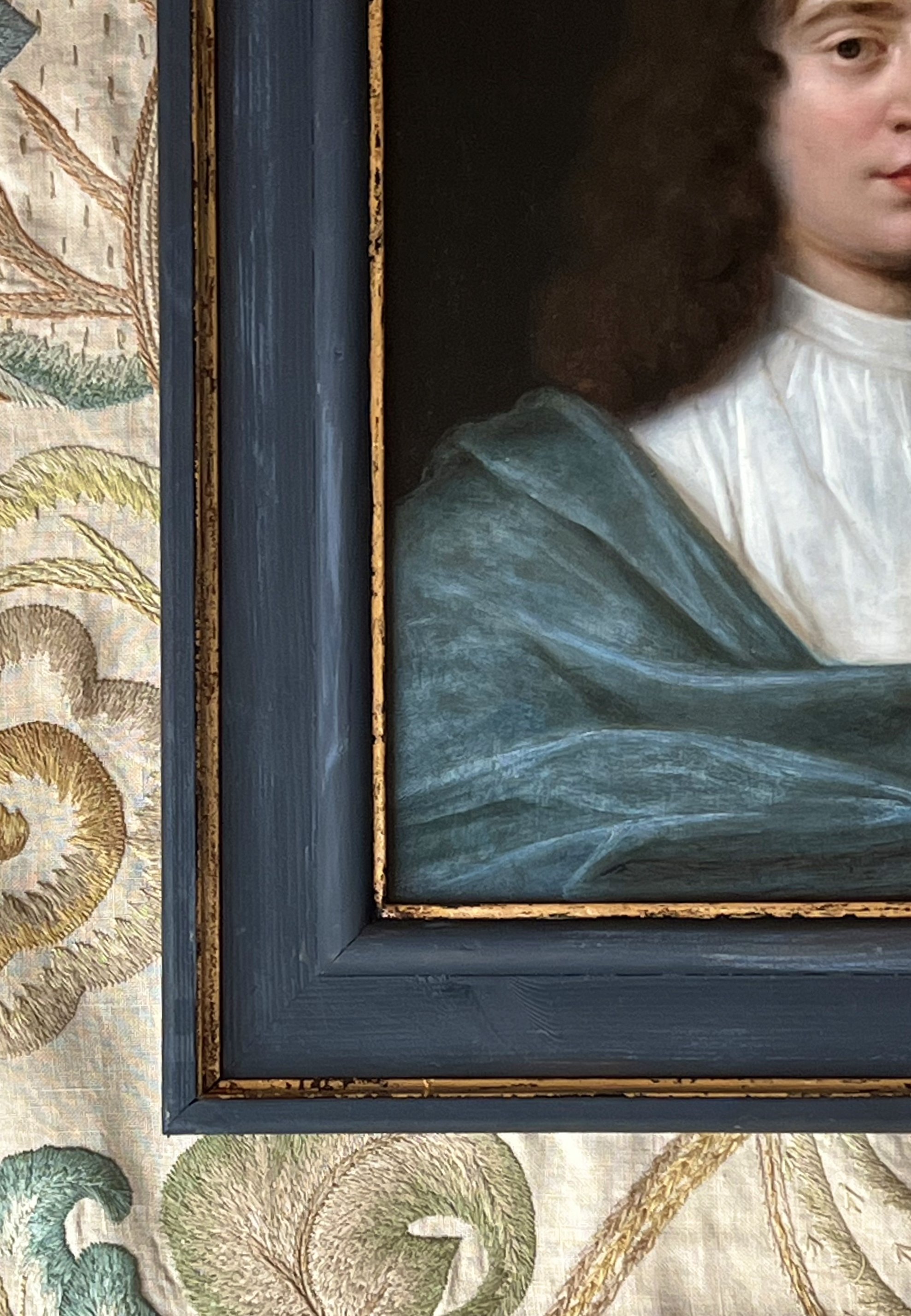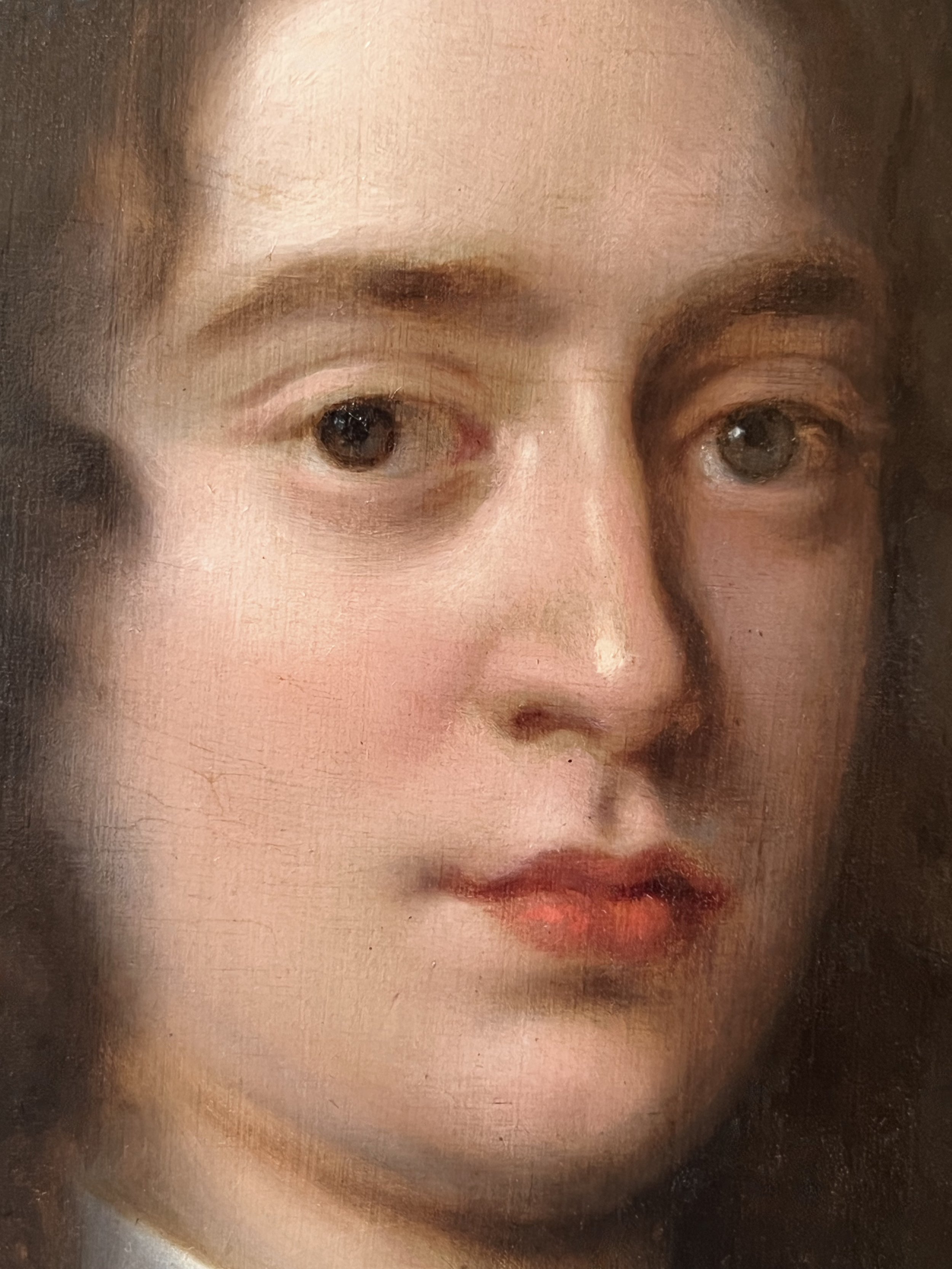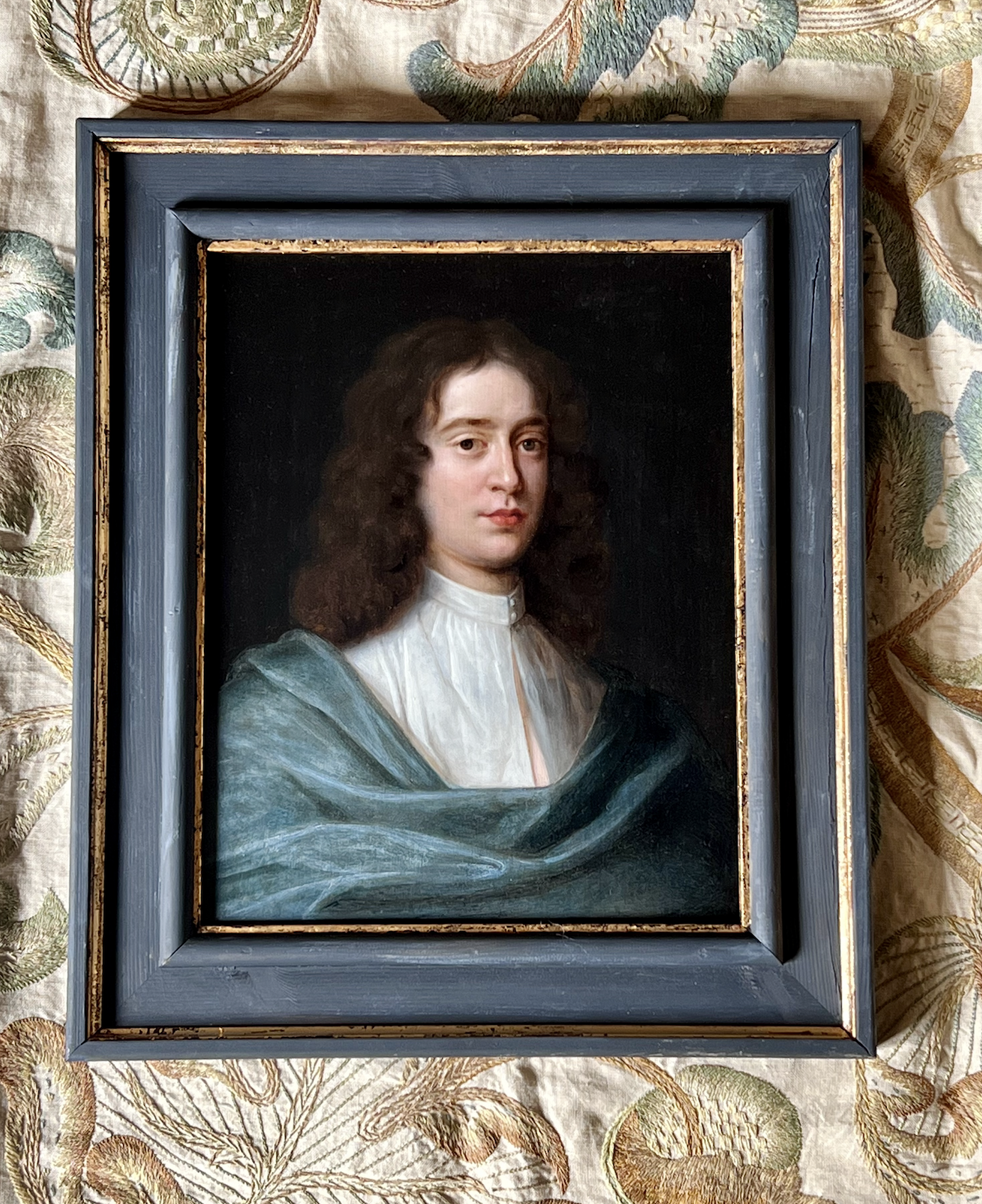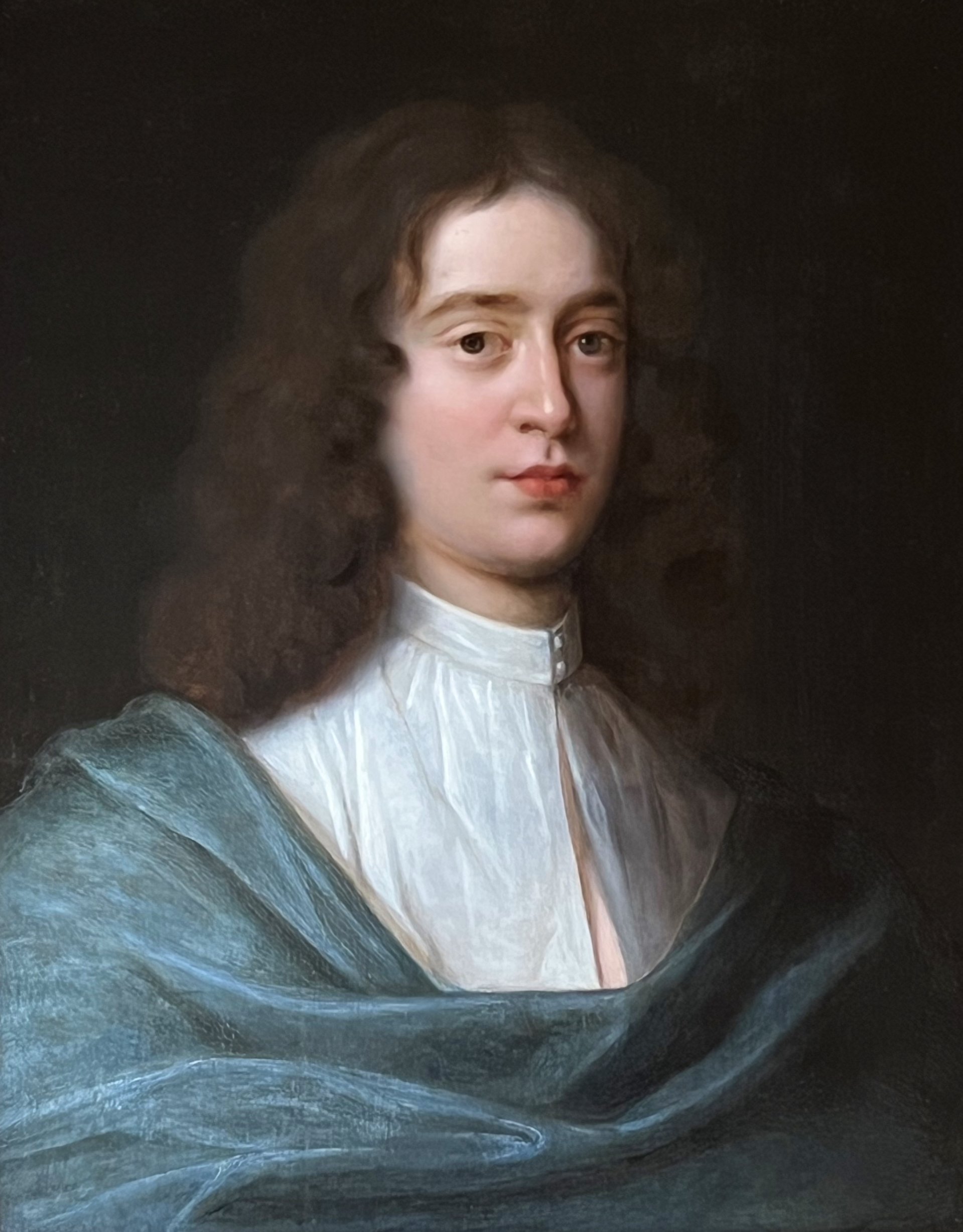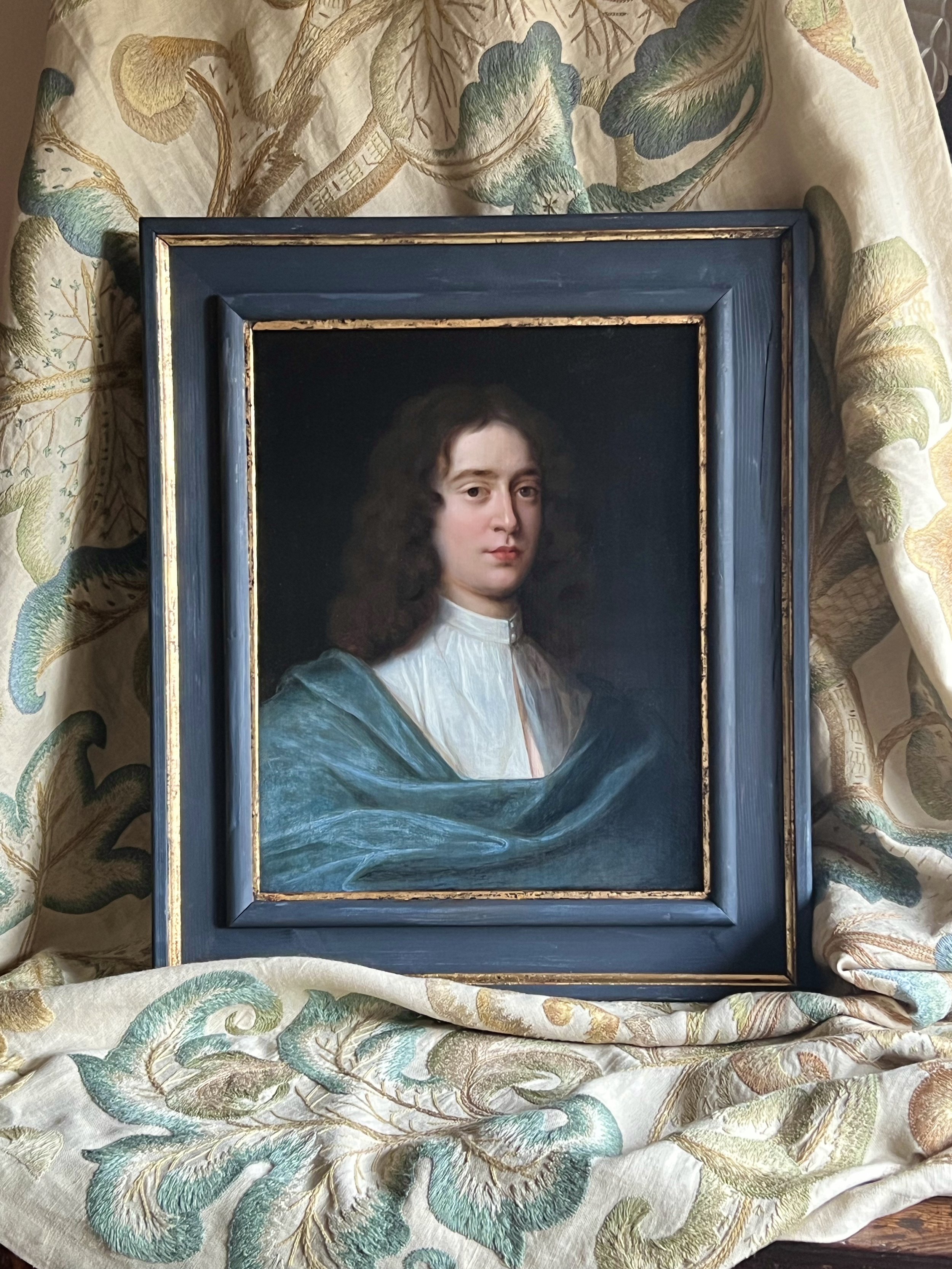Fine and intimate oil on panel portrait of a young gentleman circa 1670 Attributed to Theodore Rousel
With his smooth skin and wide eyed gaze this striking subject exhibits the male ideal of beauty associated with the second half of the seventeenth century. He has heavy lidded oval eyes and cupid - bow lips as well as the slightly heavy jaw are seen in both male and female portraits of this era.
The elegant sitter is depicted half length wearing a white linen shirt and a blue silk cloak with his curly chestnut hair tumbling naturalistically around his shoulders.
Linen came in many grades of fineness and it was worn next to his skin to provide a washable layer. It was usual to want to display its snowy whiteness – and the costly labour- intensive process that kept it freshly laundered and clean. It is the interplay between rich silk and satin garments and the linen beneath that creates such a pleasing contrast of texture and colour within this portrait.
It was fashionable in the second half of the seventeenth century for men to be depicted in ‘undress’ (in a kind of dressing gown called a ‘banyan’) but it is highly unusual to see a man depicted in just his shirt, as this would have been regarded as an undergarment. The revealing flash of white flesh at the front of the sitters chest further confirms that he is delightfully ‘deshabille’
This fine and jewel like work is clearly an intimate piece that was made for a close companion ( it may even be a smaller riccordo /momento of a larger work ) Like us they would have enjoyed the sense of dress/undress and drapery that gives this portrait the semi-timeless air that was popularised by the paintings of Van Dyck, and his great admirer Lely.
THEODORE ROUSEL (1614-1689)
Aliases: Theodore Rousel; Theodore Rousseel; Theodore Roussel; Theodore Russel.
Born in London, his father, Nicasius, was a goldsmith and jeweller, who left Bruges for England about 1573 and settled in the parish of St Anne, Blackfriars, London; his second wife, Theodore’s mother, was the sister of Cornelis Jonson van Ceulen.
The Russells were connected with the Gheeraerts, de Critz and Oliver families. Theodore’s son, Anthony Russell, who provided George Vertue with information concerning 17th-century artists, stated that Theodore had studied under Jonson and van Dyck, had been employed by such patrons as the 3rd Earl of Essex and the 1st Earl of Holland, and ‘was a lover of ease & his Bottle’.
Provenance: Private collection New England. Label verso recording that the painting was sold at the Stowe House sale and naming the sitter as the 2nd Duke of Buckingham.
I am most grateful to Jacqui Ansell, Senior Lecturer, Christie’s Education for the detailed information and analysis that she has provided on fashion and costume.
Higher resolution images on request.
Worldwide shipping available.
Board: 14.5” x 12” / 40cm x 30cm.
Framed: 20.75” x 17.75” / 53cm x 45cmFine and intimate oil on panel portrait of a young gentleman circa 1670 Attributed to Theodore Rousel
With his smooth skin and wide eyed gaze this striking subject exhibits the male ideal of beauty associated with the second half of the seventeenth century. He has heavy lidded oval eyes and cupid - bow lips as well as the slightly heavy jaw are seen in both male and female portraits of this era.
The elegant sitter is depicted half length wearing a white linen shirt and a blue silk cloak with his curly chestnut hair tumbling naturalistically around his shoulders.
Linen came in many grades of fineness and it was worn next to his skin to provide a washable layer. It was usual to want to display its snowy whiteness – and the costly labour- intensive process that kept it freshly laundered and clean. It is the interplay between rich silk and satin garments and the linen beneath that creates such a pleasing contrast of texture and colour within this portrait.
It was fashionable in the second half of the seventeenth century for men to be depicted in ‘undress’ (in a kind of dressing gown called a ‘banyan’) but it is highly unusual to see a man depicted in just his shirt, as this would have been regarded as an undergarment. The revealing flash of white flesh at the front of the sitters chest further confirms that he is delightfully ‘deshabille’
This fine and jewel like work is clearly an intimate piece that was made for a close companion ( it may even be a smaller riccordo /momento of a larger work ) Like us they would have enjoyed the sense of dress/undress and drapery that gives this portrait the semi-timeless air that was popularised by the paintings of Van Dyck, and his great admirer Lely.
THEODORE ROUSEL (1614-1689)
Aliases: Theodore Rousel; Theodore Rousseel; Theodore Roussel; Theodore Russel.
Born in London, his father, Nicasius, was a goldsmith and jeweller, who left Bruges for England about 1573 and settled in the parish of St Anne, Blackfriars, London; his second wife, Theodore’s mother, was the sister of Cornelis Jonson van Ceulen.
The Russells were connected with the Gheeraerts, de Critz and Oliver families. Theodore’s son, Anthony Russell, who provided George Vertue with information concerning 17th-century artists, stated that Theodore had studied under Jonson and van Dyck, had been employed by such patrons as the 3rd Earl of Essex and the 1st Earl of Holland, and ‘was a lover of ease & his Bottle’.
Provenance: Private collection New England. Label verso recording that the painting was sold at the Stowe House sale and naming the sitter as the 2nd Duke of Buckingham.
I am most grateful to Jacqui Ansell, Senior Lecturer, Christie’s Education for the detailed information and analysis that she has provided on fashion and costume.
Higher resolution images on request.
Worldwide shipping available.
Board: 14.5” x 12” / 40cm x 30cm.
Framed: 20.75” x 17.75” / 53cm x 45cmFine and intimate oil on panel portrait of a young gentleman circa 1670 Attributed to Theodore Rousel
With his smooth skin and wide eyed gaze this striking subject exhibits the male ideal of beauty associated with the second half of the seventeenth century. He has heavy lidded oval eyes and cupid - bow lips as well as the slightly heavy jaw are seen in both male and female portraits of this era.
The elegant sitter is depicted half length wearing a white linen shirt and a blue silk cloak with his curly chestnut hair tumbling naturalistically around his shoulders.
Linen came in many grades of fineness and it was worn next to his skin to provide a washable layer. It was usual to want to display its snowy whiteness – and the costly labour- intensive process that kept it freshly laundered and clean. It is the interplay between rich silk and satin garments and the linen beneath that creates such a pleasing contrast of texture and colour within this portrait.
It was fashionable in the second half of the seventeenth century for men to be depicted in ‘undress’ (in a kind of dressing gown called a ‘banyan’) but it is highly unusual to see a man depicted in just his shirt, as this would have been regarded as an undergarment. The revealing flash of white flesh at the front of the sitters chest further confirms that he is delightfully ‘deshabille’
This fine and jewel like work is clearly an intimate piece that was made for a close companion ( it may even be a smaller riccordo /momento of a larger work ) Like us they would have enjoyed the sense of dress/undress and drapery that gives this portrait the semi-timeless air that was popularised by the paintings of Van Dyck, and his great admirer Lely.
THEODORE ROUSEL (1614-1689)
Aliases: Theodore Rousel; Theodore Rousseel; Theodore Roussel; Theodore Russel.
Born in London, his father, Nicasius, was a goldsmith and jeweller, who left Bruges for England about 1573 and settled in the parish of St Anne, Blackfriars, London; his second wife, Theodore’s mother, was the sister of Cornelis Jonson van Ceulen.
The Russells were connected with the Gheeraerts, de Critz and Oliver families. Theodore’s son, Anthony Russell, who provided George Vertue with information concerning 17th-century artists, stated that Theodore had studied under Jonson and van Dyck, had been employed by such patrons as the 3rd Earl of Essex and the 1st Earl of Holland, and ‘was a lover of ease & his Bottle’.
Provenance: Private collection New England. Label verso recording that the painting was sold at the Stowe House sale and naming the sitter as the 2nd Duke of Buckingham.
I am most grateful to Jacqui Ansell, Senior Lecturer, Christie’s Education for the detailed information and analysis that she has provided on fashion and costume.
Higher resolution images on request.
Worldwide shipping available.
Board: 14.5” x 12” / 40cm x 30cm.
Framed: 20.75” x 17.75” / 53cm x 45cm
